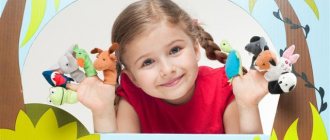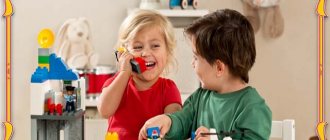Formation of communication abilities in preschool age
Speech is a universal means of communication that helps convey feelings, knowledge, and wishes. Without words, it is difficult to ask for something or communicate your intentions.
However, children, due to their limited age capabilities, are just beginning to master such an important tool.
From the first years of life, a child is focused on communication. He is friendly, smiling, and willing to make contact. But, if until the age of three the baby tries to interact with others, holding on to his mother or father’s hand, then in preschool age he increasingly has to do without the direct support of an adult.
By communicating with each other, children develop and gain new experiences. Some of them are proactive and take a leading position in the game. Others are responding to this initiative and adopting the proposed rules. Still others are observant and adopt those forms of communication that appeal to them.
The development of children's communicative culture is facilitated by the help of educators and parents. Adults support, suggest what is best to do, and also help develop the ability to demonstrate important elements of communication that form the basis of emotional intelligence:
- Sympathy and empathy;
- The ability to imagine what another feels;
- Containing emotions (without screaming, crying and stamping your feet);
- Understanding that each person is individual and may feel differently.
Nonverbal stage of communication
Nonverbal communication is conversation without the use of speech. This form of contact is available at any age. Developmental researchers say that children are capable of perfectly imitating the facial expressions of adults, and are not yet constrained by conventions and norms.
This skill is especially important for establishing contact with peers. In early preschool age, it is quite difficult to get acquainted and come to an agreement with the help of speech, but improvised means come to the rescue.
Playing nearby in the sandbox, a preschooler smiles and invites his new friend to make Easter cakes together. Confirming this proposal is very simple - hold out a spatula or mold. It’s also common for kids to want to show what they can do. Attention is more often attracted by touch, and the sand castle is shown using the hands.
At this stage, it is also easier for preschoolers to express sympathy and antipathy non-verbally. Those they love get hugs and kisses. Adults and children who do not enjoy the baby’s favor may see a frown on their forehead, the child’s back, or even an attempt to hide behind their mother’s skirt.
Communicative-speech stage
As the vocabulary is filled, the development of communication abilities in preschoolers accelerates. Questions arise: “Where?”, “Where?”. The baby adds simple explanations to non-verbal signals inviting communication: “My car,” “Pour sand into the bucket.”
At 4 years old, a child can easily make narrative sentences. Communicating with other children, the preschooler discovers his involvement in the community and joyfully states: “We roll cars,” “We run.”
Five-year-old children are able to invite a peer to play and actively use more complex constructions: “Let’s play shop, I’ll sell, and you’ll buy.”
In the communication of younger preschoolers, there are also conflict situations. For the most part, they are provoked by children's egocentrism. Sometimes a child will never agree to give his toy. On the other hand, there are children who, when they see an attractive car or scoop from another child, want to get it immediately.
In any of these cases, it is important that the adult explains to the child how to ask a friend to share a toy. It is necessary to teach little communicators the accepted polite phrases that regulate communication.
From the age of five, a preschooler, thanks to the development of coherent speech and awareness of the importance of words for communication, moves to a higher level of communication. Communication skills at this stage become especially important.
Article “FORMATION OF COMMUNICATION SKILLS IN EARLY CHILDREN IN PLAY”
“FORMATION OF COMMUNICATION SKILLS IN EARLY CHILDREN IN PLAY”
Author: Krasilnikova A.V.
kindergarten teacher
"D/s No. 109" Magnitogorsk
The main task of the state and society in relation to children is to provide optimal conditions for the development of their individual abilities, the possibility of self-regulation, the formation in the child of the foundations of a respectful attitude towards others, the ability to communicate and interact, and familiarization with universal human values. Currently, there is an intensive development of preschool education in different directions: increasing interest in the personality of a preschool child, his uniqueness, and the development of his potential capabilities and abilities.
The Federal State Standard for Preschool Education highlights the educational area “Socio-communicative development”, which indicates the need to develop communication and interaction of the child with peers and adults.
The acquisition of communication skills by children begins from the moment of birth, since it is during infancy that the child first enters the social world of relationships. The development of communication skills at an early age is formed together with the process of mastering nonverbal and verbal components of speech in various types of activities.
The basis for the formation of communication skills is joint activity with the child. Communication with an adult leads to an enrichment of means of communication that become understandable to both parties in the process of interaction. Communication with a peer is also a positive experience for children, since the child does not feel inflated demands on himself in this communication and communicates as equals, while experiencing an encouraging feeling for communication.
Communication is one of the most important human needs, the main way of human life and the condition for its development. Only in communication and in relationships with other people can a person feel and understand himself, find his place in the world, socialize, and become a socially valuable person. In this regard, the problem of child development in interaction with the world around him becomes especially relevant at the present stage.
Relationships with other people begin and develop most intensively in preschool age. The first experience of such relationships becomes the foundation on which further personal development is built. The subsequent path of his personal and social development, and therefore his future fate, largely depends on how the child’s relationships develop in the first group in his life - the kindergarten group.
As soon as a child is born, he gradually masters social experience through emotional communication with adults, through objects around him, through toys, speech. It is the early forms of communication that largely determine their further development and influence the development of a person’s personality, his attitude towards people around him , to yourself, to the world.
The communication process is, first of all, a process of establishing contacts. During this process, information is exchanged, its perception and understanding by communicating people, as well as mutual perception, understanding and evaluation of each other. It is in communication that empathy arises, likes and dislikes are formed, the nature of relationships is formed, various contradictions appear and are resolved.
During communication, the child feels and understands that he is loved and appreciated, that his relatives and friends need him. The ability to communicate is determined by certain personality characteristics that ensure the effectiveness of its interaction and compatibility with other people.
The ability to communicate includes three main components:
— motivational (“I want to communicate”);
— cognitive (“I know how to communicate”);
— behavioral (“I can communicate”).
At an early age (a unique period in a person’s life), a child intensively masters speech, communication, and the culture of human thinking. The baby copies, reflects in actions and words, in emotional manifestations and actions the world in which he lives. It is in the early years that the foundations of a child’s health and intelligence are laid.
The ability to understand speech and speak becomes an important means of development for a child of the third year of life. At this age, the functions of speech expand, and it becomes not only a means of communication between a child and an adult, but also the main means of communication with other children. Mastering communication skills provides the child with full inclusion in communication as a process of establishing and developing contacts with people that arise based on the need for joint activities.
Work on developing communication skills should be regular and organically included in all types of activities.
The formation of a child’s personality and the development of all his abilities occur much more effectively in play. Play is the most accessible and interesting way for a child to process, express emotions and impressions.
The process of play is one of the effective means of socialization of young children. Participation in the game creates favorable conditions for the development of a sense of partnership. It is during play activities that the development of communication and interaction of children with each other and adults will be most effective.
In preschool age, the leading activity is play, so children can develop communication skills through communicative games. These games teach to be kind to each other, to show love and respect for others, to express empathy, care and compassion.
In our work, we systematically use game data. I propose to consider some of them:
Game "Looking for a friend"
Goal: Teaching children cooperation skills, moving from playing “side by side” to playing “together”.
Procedure: Children are given one toy each (a set consisting of 2-3 toys of the same type: hares, bears, dogs, etc.) The teacher tells the children that now they will dance along with the animals. But it’s boring for one bunny or one bear to dance, so while the music is playing, each child must find friends for his little animal. (At the first stage, the teacher draws attention to the fact that there is not just one bunny in the set (a bear, a dog, but several). When the music starts playing, the children walk around the room and look for children with paired toys, that is, they are looking for a friend for their animal. When a friend is found , children dance along with toys (Instead of toys, you can use pictures of animals or medals that can be hung on your chest).
Game "Pass the Ball"
Goal: to develop the ability to interact with peers.
Progress: Children stand opposite each other. The teacher shows the children how to correctly hold and pass the ball to another child, calling him by name (“Na, Sveta”). The game is emotionally supported by an adult.
Game "Flag"
Goal: develop the ability to respond to your name and show sympathy to peers
Progress: To play, you will need a checkbox Children stand in a circle: Children stand in a circle. We saw a flag: The teacher is holding the flag. “Who should I give it to, who should I give it to, who should I give the flag to?” Go out, Vanya, into the circle, take the flag, Vanya. Come out, come out, raise the flag higher! Vanya takes the flag and raises it. Here our Vanya comes and carries his flag: “To whom should I give, to whom should I give, to whom should I pass the flag!” Vanya chooses a child to whom he passes the flag, and the game is repeated.
Game "Locomotive"
Goal: to teach the child to respond to his name, remember the names of peers, act according to demonstration and verbal instructions.
Progress of the game: the teacher explains to the children that now they will play train. The main engine will be the adult, and the children will be the carriages. He calls the children one by one and emotionally comments on everything that is happening: “I will be the locomotive, and you will be the carriages. Peter. Come to me, stand behind me, hold my belt, like this. Now Vanya, come here, stand behind Petya, hold him by the belt.” Once all the children have lined up, the “train” sets off. An adult imitates the movement of a steam locomotive “Choo-choo, oo-oo-oo!” encourages children to repeat them.
Thus, we can say that the most important condition for the psychological development of a small child is communication. There are a number of rules of interaction in communication that can also be applied to the rules of communication with a child under 3 years old.
1. Show sincere interest in the child while communicating with him;
2. Be a good listener; encourage children's speech activity;
3. Pay attention not only to the word, but also to the sound of the voice, facial expressions, gestures, posture
4. When communicating with a child, sincerely recognize his merits;
5. Praise your child, even the most modest success, and be sincere in your recognition. Since an important component of communication is a friendly attitude towards each other, showing love and respect for others.
List of used literature:
- Bodalev, A.A. On the study of communication: Psychology of communication / A.A. Bodalev. – M.: Education, 2000. – 396 p.
- Vygotsky, L.S. Game and its role in the psychological development of a child / L.S. Vygotsky // Developmental Psychology. – St. Petersburg, 2001. – P. 56-79.
- Godovikova, D.B. The influence of communication with adults on children’s communication with peers: Research on problems of developmental and pedagogical psychology / D.B. Godovikova; edited by M.I. Lisina. – M., 1980. – 274 p.
- Kovylova, E.V. Psychology of relationships in small groups: General and age-related features / E.V. Kovylova. – Minsk: Fetra Systems, 2000. – 431 p.
- Smirnova, E. Games aimed at developing a friendly attitude towards peers / E. Smirnova, V. Kholmogorova // Preschool education. – 2003. – No. 8. – pp. 73-77.
Development of communication abilities of older preschoolers
A child who prefers to spend time alone often does so for reasons of inability to be interesting and communicate well. Being among his peers, he may experience shyness, lack of self-confidence, or be aggressive. Therefore, preschool development requires the allocation of a significant amount of time for the formation of communication skills.
The conditions for the development of communication abilities imply two complementary paths. The first is active communication with adults and adopting their communication model and style of communicative behavior. The second is spending time with peers, during which children constantly learn from each other.
With the development of communicative abilities, children of senior preschool age develop stable motives for communication and a desire to interact with both adults and peers.
Borrowing adult communication models
By communicating with adults, a preschooler develops the basic components of communication skills. The ready-made model that they observe among relatives and educators allows them to understand the following:
- When to make contact, that is, to understand under what conditions conversations are appropriate and when to remain silent;
- How to organize communication, how to resolve conflicts, clearly see emotional empathy;
- What norms and rules does communication require, that is, to determine for yourself the boundaries of acceptable harshness, frankness, and playfulness.
Also, dialogues with adults mean obtaining information about knowledge and cultural values. By example, children learn to tell stories, learn how to make their stories interesting and exciting.
Development of abilities in communicating with children
The fundamental difference between communication with peers is increased emotional intensity. In this case, boundaries are removed, and children learn to be sincere and artistic. Their communication includes causeless laughter, antics, loud statements that turn into screaming.
In this way, children experiment, independently looking for ways to attract attention to themselves without the help of adults.
Also in peer communication there may be elements such as:
- Unpredictable combinations of syllables and sounds - attempts to create your own language;
- Lack of rules;
- Having harsh words to help release emotions.
If, when talking with adults, a preschooler asks and listens more, then in conversations with peers he strives to speak out himself, even if this means shouting down others. Moreover, the preschooler expects evaluation or new information from teachers and parents. Just by chatting with friends, he learns to express himself and emotions, express desires, show his mood through words, and even tries to take on leadership functions, demonstrating initiative and trying to manage the rest of the company.








